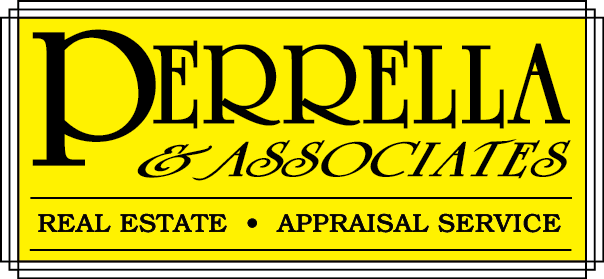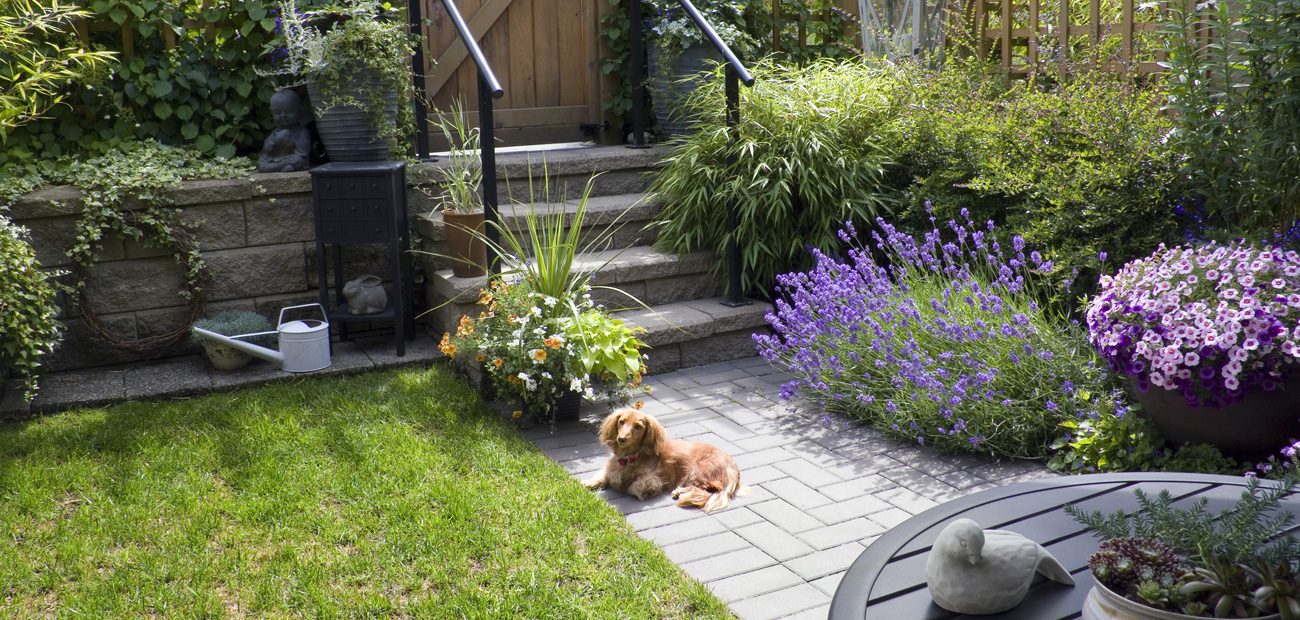
©Barbara Helgason – Fotolia.com
The Art of the Small Garden
Bigger isn’t always better when it comes to outdoor spaces. Small gardens can be jewel boxes that delight the senses without requiring as much maintenance or expense as their larger counterparts.
For years, the most appealing residential backyards featured sprawling plots with multiple “rooms”—separate areas for cooking and dining, growing gardens full of vegetables and flowers, and recreational space for a pool or a children’s play area. But as more homeowners look to lower housing costs and maintenance, they’re paring down on the time and funds going toward landscape upkeep.
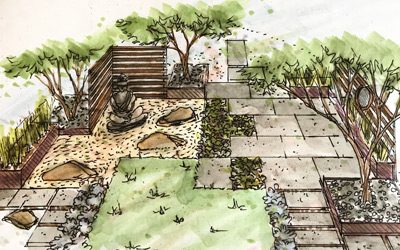
© Laurie Van Zandt, The Ardent Gardener
Between smaller urban backyards and terraces and new homes being built with smaller outdoor footprints, gardens are scaling down proportionately. For example, a homeowner living in a bungalow with a small yard can still enjoy the trickling sounds of water, but it might be a bubbling fountain or spa rather than elaborate outdoor water features or a swimming pool. The same is true for vegetable gardens. Rather than planting large raised beds, one or two metal troughs or ceramic pots filled with a mix of vegetables and herbs still could provide delicious fixings for a homegrown meal.
Landscape designer Laurie Van Zandt, founder of The Ardent Gardener in Huntsville, Utah, finds her clients with smaller yards are just as happy. “Most want to putter [in the yard] but don’t want to be gardeners,” she says. More clients want to sit with a cup of coffee or glass of wine and enjoy their outdoor space than be wedded to the ongoing weeding and maintenance that larger gardens often require.

© Amber Freda Landscape Design
However, gardens shouldn’t be done away with completely. Greenery in small or large doses benefits a home owner’s physical and psychological well-being, and it may also help sell a listing faster and for a better price. In New York, Amber Freda, a landscape designer who founded Amber Freda Garden Design 15 years ago, has seen her business grow steadily. “The amount of finished outdoor gardens rather than raw spaces has increased. They definitely are a selling feature, especially when they have some features such as outlets for electricity, faucets for water, and a gas line for a grill,” she says.
Making the Best Use of Space
To help your clients with small yards or terraces create a garden they love—that will also appeal to future buyers—keep the five senses in mind: sight, sound, smell, taste, and touch. Also consider the area’s climate and the property’s terrain, soil, and amount of sun and shade. Then find out what their budget is, including installation and ongoing maintenance.
Get inspired with these tips from garden experts, who’ve shared some of their favorite elements that can be mixed and matched.
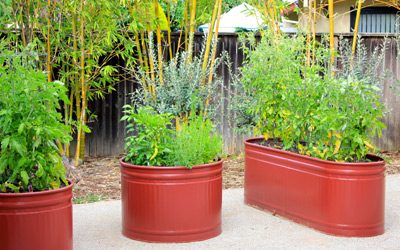
© Michael Glassman
Edibles. Eating healthy has inspired homeowners to grow their own produce, and for some, it adds an element of fun. Though small square footage will necessitate paring down the list of possibilities, some vegetables are propagated specifically for their small size, such as tomatoes, artichokes, and carrots, says Edward Furner, a landscape architect with Mariani Landscape in Lake Bluff, Ill., outside Chicago. Certain fruit trees have also been genetically developed for smaller spaces such as peaches, nectarines, and some citrus.
To both eliminate a lot of kneeling and bending, try using galvanized horse troughs or big pots for planting since they don’t require construction, suggests Sacramento, Calif.-based landscape designer Michael Glassman, co-author with this writer of The Garden Bible (Images Publishing, 2015). Edible flowers could also be considered. To make watering easy, add drip irrigation or soaker hoses.
Fire. A fire feature is among today’s top outdoor requests. For smaller yards, a fire pit, bowl, or element built into a table can provide that romantic glow (and many are portable). Unlike fireplaces, most fire pits don’t require permission from a local municipality, though they may require a certain setback from the house. Van Zandt also suggests inexpensive tiki torches to add to the fire ambiance.
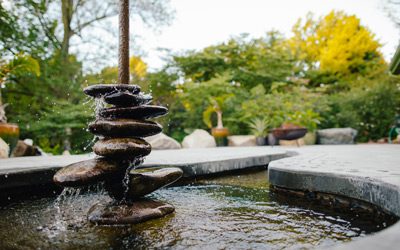
© Sun Valley Landscaping Omaha, NE, a member of the National Association of Landscape Professionals
Water. While the sound of trickling water delights many, it offers another purpose: to block other noise. These days it’s easy to find a large urn or an attractive container that can be retrofitted with a bubbler to recirculate water, as Van Zandt did for a client who had a rock collection. She stacked them together and drilled a hole so water could trickle out. Furner says he’s receiving more requests from clients for small lap pools.
One type of water feature that has lost appeal is the koi pond, due to heavy maintenance, says Glassman. For drought-ravaged areas—or for homeowners who want to cut water use—Furner suggests faux grass, which has become much more realistic in recent years. Some companies also manufacture lifelike outdoor plants, such as boxwood.
Cooking and eating. For years outdoor kitchens grew larger and larger, with higher-end models incorporating a grill with rotisserie, sink, and refrigerator—even a beer tap, pizza oven, countertops, and storage. But many found the investment overkill with access to their indoor kitchens just steps away.
When helping one client who enjoys cooking and entertaining, landscape architect Jack Carman of Design for Generations in Medford, N.J., transformed the small patio outside her cottage by staining the white concrete tan to cut the glare, then adding a grill, table with umbrella for shade, chairs, planting beds, and low-voltage lights to illuminate a path for safety.
Wildlife-friendly. The right plants will attract hummingbirds, butterflies, bees, moths, flies, beetles, and other pollinators that give back to a garden of any size, says Missy Henriksen, vice president of public affairs at the National Association of Landscape Professionals. “Choose plants that flower at different times of the year, which will vary by region,” she says. Many online guides offer information, including the U.S. Department of Agriculture.

© Lifescape Colorado, Denver, CO, a member of the National Association of Landscape Professionals
Soul-nourishing. A small garden can become a spiritual retreat, helping homeowners unwind and destress. Glassman built a raised platform for one client to practice tai chi. A lawn panel can offer the same option with a mat placed atop grass. Hospitals have become a good source of information since many have installed their own gardens to help patients recover and offer a respite place for family members and staff as well. The Mercy Medical Center in Baltimore, Md., has three rooftop gardens, including a water feature in its Mary Catherine Bunting Center.
Privacy. Shielding gardens and outdoor spaces from neighbors has become more of a priority as homeowners gravitate to urban areas and downtown suburbs. One way is to go vertical and plant along a garage, outbuilding, or fence to camouflage or block out neighboring properties. Choose perennials in colder climates to eliminate the need to replant. Glassman prefers to use an iron or wood trellis rather than grow greenery directly on a dwelling because it’s easier to perform maintenance. He favors potato, trumpet, and creeping fig vines that grow densely in his northern California climate. Another option for privacy is to plant shrubs or trees with multiple trunks. Henriksen says succulents have become a popular option. But with any choice, the homeowner should ask how big the plant will grow when it matures so that they leave enough room, Glassman says.
Container gardens are a third alternative. Henriksen recommends that each pot have three types of plants: a “thriller” or tall plant that makes a strong statement in form or color, a “filler” that fills the space and hides the soil, and a “spiller” that weeps over the edge. Master gardener Carole Aine Langrall, owner of The Flower Spy in Santa Fe, N.M., and Baltimore likes to limit the palette to a few hues and textures to give the illusion of more space.
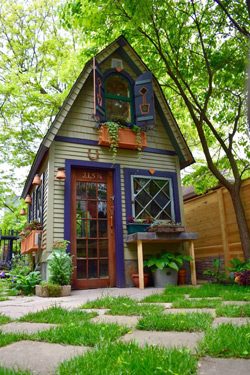
© Jim Charlier
Decorative. Whether it’s hardy artwork, whimsical found objects, or wind chimes, decorative elements personalize a space. However, decorative items should be limited so they don’t overcrowd a small garden, Van Zandt says. One striking piece can create a beautiful focal point to direct the eye, says Henriksen.
But paring down isn’t for everyone. Many of the 400 amateur gardeners who open their colorful, quirky, original gardens in Buffalo, N.Y.’s annual Garden Walk Buffalo weekend event each July disregard the simplicity mantra. Graphic designer Jim Charlier, who participates yearly, recently co-authored the book Buffalo-Style Gardens (St. Lynn’s Press, 2019) with garden writer Sally Cunningham. He designed his small garden for eating and entertaining, planted a collection of climbing plants to block neighboring homes, and built a green potting shed that mimics his 1897 green Dutch Colonial-style home to hold tools. The pedigree of a garden featured on the 25-year-old tour—the largest of its type in the country—definitely helps to sell homes, Charlier says.
Up in the Air: Handling Rooftop Gardens
More attention is being paid to using all outdoor areas, including urban rooftops. But working on outdoor spaces that are high up adds additional challenges.
Make sure your clients consult a structural engineer to determine how much furniture, decking, and soil a terrace, balcony, or roof can support and how to transport those items up top. Where an elevator may not be large enough, a crane is required, which increases costs, says landscape architect Marc Nissim, owner of the Harmony Design Group in Westfield, N.J.
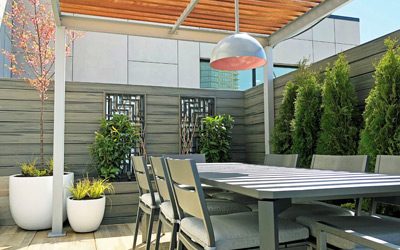
© Amber Freda Landscape Design
Landscape designer Amber Freda, whose eponymous firm is based in New York, helped clients with a garden in that city’s West Village neighborhood where restrictions limited them to 35 pounds per square foot. The building also didn’t have an elevator. Her solution: lightweight potting soil and custom red cedar planters.
Local weather conditions may dictate certain precautions as well. Furniture may need to be bolted down so it doesn’t fly away with strong wind gusts. Flooring needs to be durable to withstand the elements. Nissim likes ipe planks, a dense wood decking material that snaps together and doesn’t require repainting. There’s also less costly porcelain pavers that are hard and durable yet not as heavy as paving stones.
A good irrigation system should be available since water tends to evaporate faster up high versus on the ground. “Look at what grows well on a mountain and that’s often the best solution for a rooftop or high garden,” says Freda.



